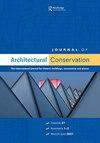Riegl’s ‘Modern Cult of Monuments’ as a theory underpinning practical conservation and restoration work
IF 0.5
3区 艺术学
0 ARCHITECTURE
引用次数: 8
Abstract
ABSTRACT ‘The Modern Cult of Monuments: Its Character and Origin’ (1903), written by Alois Riegl, is the first systematic analysis of heritage values and of a theory of restoration. His values and concepts became fundamental principles of the Venice Charter (1964). However, in conjunction with the 50th Anniversary of the Charter in 2014, it was pointed out that the attempt to reconcile notions of the monument with the ‘postmodern’ idea of multiple and shifting values has resulted in an ever-expanding definition of the ‘monument’ – without serious questioning of the underlying principles that guide its treatment. This article analyzes Riegl’s ‘commemorative values’ and ‘present-day values’ in the light of the conservation and restoration work of the Norwegian architect Kristian Bjerknes, who in 1979 was awarded a European prize for his preservation of cultural heritage. His work illustrates how Riegl’s age value theory can be used for a wide variety of building types and situations. Bjerknes applied it as a strategy for conservation and restoration of wooden buildings, and in adapting architectural heritage to modern living conditions. He also transferred the theory to museum work and to the rebuilding of demolished buildings. His preservation work illustrates how theory and practice are interwined.里格尔的“现代古迹文化”作为实际保护和修复工作的理论基础
摘要:阿洛伊斯·里格尔(Alois Riegl)的《现代古迹文化:其特征和起源》(The Modern Cult of Monuments:Its Character and Origin)(1903)是对遗产价值和修复理论的首次系统分析。他的价值观和理念成为《威尼斯宪章》(1964年)的基本原则。然而,在2014年《宪章》颁布50周年之际,有人指出,试图将纪念碑的概念与多元和不断变化的价值观的“后现代”理念相调和,导致了对“纪念碑”的定义不断扩大,而没有对指导其处理的基本原则提出严重质疑。本文结合挪威建筑师克里斯蒂安·比约克内斯的保护和修复工作,分析了里格尔的“纪念价值”和“现代价值”。比约克内斯于1979年因其文化遗产保护而获得欧洲奖。他的作品说明了里格尔的年龄价值理论如何适用于各种建筑类型和情况。Bjerknes将其作为木建筑的保护和修复策略,并将建筑遗产适应现代生活条件。他还将这一理论转移到博物馆工作和被拆除建筑的重建中。他的保存工作说明了理论和实践是如何交织在一起的。
本文章由计算机程序翻译,如有差异,请以英文原文为准。
求助全文
约1分钟内获得全文
求助全文

 求助内容:
求助内容: 应助结果提醒方式:
应助结果提醒方式:


